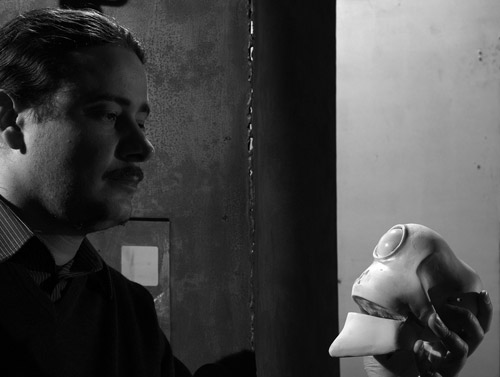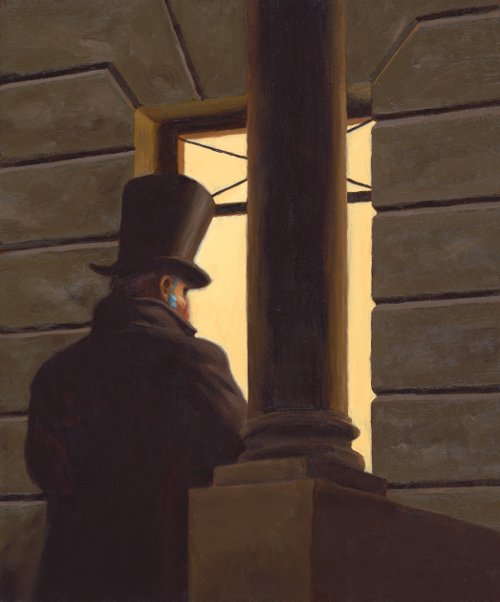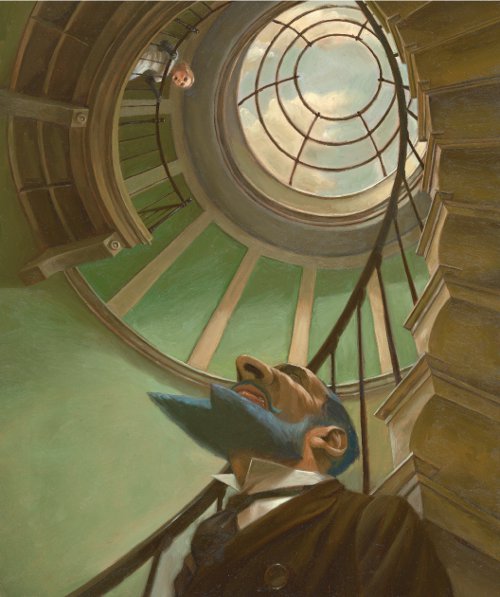Cristiana Clerici’s International Spotlight #5:
An Interview with Italian Illustrator, Maurizio Quarello
 May 19th, 2011 by jules
May 19th, 2011 by jules

 Jules: It’s time to welcome again the very smart Italian blogger with kickin’-good taste, Cristiana Clerici (pictured right), for another spotlight on international illustration. Today, she’s interviewing Italian illustrator Maurizio Quarello, pictured above, who talks about his work, what being stubborn will get you in this field, the appeal of cinema with regard to his work, his inspirations, and how his books initially only get a five-minute window with him. (I love that part.) As always, I am grateful that Cris stops by here to show me and 7-Imp readers what is happening in contemporary picture books over in Europe. To get the low-down on what I call Cristiana Clerici’s International Spotlights, visit this page of the site. I thank her kindly for contributing today. I shall kick back with my coffee and take in their conversation.
Jules: It’s time to welcome again the very smart Italian blogger with kickin’-good taste, Cristiana Clerici (pictured right), for another spotlight on international illustration. Today, she’s interviewing Italian illustrator Maurizio Quarello, pictured above, who talks about his work, what being stubborn will get you in this field, the appeal of cinema with regard to his work, his inspirations, and how his books initially only get a five-minute window with him. (I love that part.) As always, I am grateful that Cris stops by here to show me and 7-Imp readers what is happening in contemporary picture books over in Europe. To get the low-down on what I call Cristiana Clerici’s International Spotlights, visit this page of the site. I thank her kindly for contributing today. I shall kick back with my coffee and take in their conversation.
Without further ado, here is Cris. Enjoy.
Cris: I have already discussed Maurizio Quarello’s books here and here and, from what I’ve told you, I am sure my personal admiration for this artist from Piedmont is quite clear. And, based on all the recognitions he has obtained, it seems I’m not the only one.
Well, after the other interviews I conducted with some of the teachers at Ars In Fabula, I had the good fortune to interview Maurizio as well, even if not in Macerata. Though I wasn’t surrounded by the familiar flights of steps typical of Macerata, despite the absence of that peculiar fairytale-like atmosphere, I have to say that my aquaintance with Maurizio widely filled any possible absence. In fact, other than being the great illustrator he is, Maurizio is a very pleasant person, able to put you at ease without many ceremonies. Nothing seems to escape his biting glance, not a gesture nor a movement and, meanwhile, he gives the sensation that all information is carefully registered, weighted up and filed to then be used at the right moment. This meditative air, which from time to time seems to completely absorb him, goes along with a pleasure-seeking and playful spirit. To fully understand this, it’s more than worth it to observe his works a bit closer.
Let’s find out more about this nice illustrator…
Cris: Is there a place from your childhood you’re still bound to?
Maurizio: Sure, it’s my grandparents’ house in Monferrato. It was the last house of the village with woods all around and, of course, our favourite hobby was to explore the woods and the abandoned houses in the area.
Cris: Were you a good reader when you were a child? If so, what did you usually read?
Maurizio: I read mostly fairy tales. My favourites were the ones with ogres, devils, and witches.
Cris: Which, if any, is the first book you still remember?
Maurizio: The first books I remember clearly are the mythical Quindici. Another fundamental book has been Treasure Island, which still is one of my favourites.
Cris: Can you tell us your first memories about drawing?
Maurizio: I discovered I liked drawing when I was at my last year at nursery school. I never wanted to stop. I drew monsters, medieval knights, and animals — mostly eagles.
(Click to enlarge)
Cris: Which studies did you take?
Maurizio: At secondary school, I studied advertising / graphics arts. Everything was different then: we worked based on Bauhaus’ rules; we drew letterings by hand (!!); the study of composition was fundamental. These are all skills that are still very useful to me. After this, I studied architecture for a while at college, but I got no university degree, as I couldn’t pass scientific exams. But I have to say those studies revealed themselves as very useful in my work as an illustrator. After this, I studied at IED and then followed several illustration workshops.
(Click to enlarge)
(Click to enlarge)
(Click to enlarge)
Cris: When did you understand you wanted to be an illustrator?
Maurizio: To be honest, I believe I had always known it. Since I was a kid, I have always wanted to get a job that had to do with drawing. And then, when I discovered children’s book publishing “in the Douzou style,” I had no more doubt that this had to be my job.
Cris: What were your first moves in that direction?
Maurizio: I imagine what most people do: many interviews at specialised shows and in advertising companies, many competitions, and—in the end—the first published projects.
Cris: Were there difficult moments? If so, how did you overcome them?
Maurizio: Of course there were! After a year spent drawing and preparing projects that no publisher or artistic director wanted (and without earning a penny), I had almost decided to abandon and start looking for a “serious job.” Then, suddenly, everything changed: in the space of one month, I was told I would have three books published and, from then on, it was all downhill. I believe you can overcome difficulties only by working a lot. You have to be stubborn, and you mustn’t give up at the first difficulties.
Cris: Are there masters of illustration, or of painting, that particularly inspired you over the years?
Maurizio: Well, I should make a huge list! As for illustrators, I’ll just mention the two that, in my opinion, are the bigger ones: Wolf Erlbruch and Michael Sowa. If I have to mention some of the big masters of painting who inspired me (let’s say that I shamelessly plagiarized them), I can name: Bruegel, Bosch, Rosso Fiorentino, Giorgione, Grunewald, Leonardo, Friedrich, Dix, Grosz, Hokusai, Warhol, Goya, Degas, Hopper, and God knows how many others.
Cris: In what way do other visual arts enter your imagination, if they do at all?
Maurizio: Great cinema does have an enormous appeal on my work. I see a great number of movies, and it’s quite natural that I pour all this into my illustrations. Therefore, cuts and framings, lights, colours, and characters I see on the screen pass on to the sheet.
(Click to enlarge)
(Click to enlarge)
Cris: Your works are extremely versatile, and you pass from one illustrative register to another with great ease and with results that are always surprising. Is there one style you feel you can claim as your own?
Maurizio: I don’t know. I would say there is no particular style. I’m not interested in being “recognizable,” and I’m horrified at the idea of always making the same things. Let’s say that I’d rather tend to have a grotesque/ironic approach to subjects.
Cris: Is there a medium you prefer?
Maurizio: Maybe acrylic, though used in many different ways — though, lately I have used other techniques, like Indian ink, pencil, and oil colours, and I had great fun. As soon as possible, I would like to try making books using xylography and collage. It doesn’t stop here!
Cris: When you start a new project, do you follow a precise outline or do you follow inspiration?
Maurizio: First, impact to me is fundamental: a text must immediately “shake” me; I must immediately have images forming on my mind, colour matching, and characters must materialize. In short, what I mean is that the book, for me, is born in five minutes or it isn’t at all.
Cris: What is your biggest challenge while illustrating a text?
Maurizio: Finding the exact balance between words and images. There are texts that need to be matched with “soft” illustrations; others (maybe weaker ones) that need to be sustained and enriched by illustrations. At times, it’s fair being a bit didactic, while with others you need to be decidedly more courageous in inserting your point of view.
Cris: How important is the unsaid in illustration?
Maurizio: Very much. It’s fundamental to allude, let the reader guess, telling through symbols and external cross-references as well.
Cris: How about white space?
Maurizio: Very much. Both inside the illustration and in the general architecture of a book. It’s necessary to give illustrations breath and rhythm, and the alternating of full and empty is the best tool to obtain it.
Effets Secondaires, and…
Cris: I had the chance to see (and review) your wonderful version of Blue Beard, published by Milan Jeunesse. There is, in your illustrations to this text, a quality I shall call movie-like — in the framings, in the movement you give images. It’s an album in motion. Am I wrong?
Maurizio: No, you’re not. This book, more than others, owes a lot to my passion for cinema. I have used several cinematographic expedients, such as reverse shots, to let the reader into the book.

Cris: The other thing that struck me in Blue Beard is the use of colour, as well as some of the settings and the way you play with light, that I would almost call “Hopper-esque.”
Maurizio: Hopper is one of the masters I admire the most and that I often cite in my books. The use of colour he has and the theory of shades he built fascinate me enormously. I keep studying his works, and then I try to reinterpret it to enrich my illustrations.
Cris: Some landscape shots make me think of the great British romantic painters…
Maurizio: To be honest, I got inspired by German Romanticism—Friedrich, in particular—and Degas, together with Atget’s pictures.
Cris: Then you move to Effets Secondaires for Le Rouergue — with a totally different narrative and illustrative register. How important is it for you to change atmosphere? To pass from poetic to surreal?
Maurizio: I have to admit that, to me, the most important thing is not to get bored. This is also why I enjoy illustrating different texts and topics, because I am forced to be at stake again, to experience new resolutions and techniques. And I keep having fun.
(Click to enlarge)
Cris: In Effets Secondaires, you have a comic style that somehow reminds me a bit of Tintin, for the way you use the sign even if you “stain” it, for the main character with the prominent fringe. Can you tell me something about this picture book for which you are also author?
Maurizio: And, in fact, I love Tintin! I wanted to play a little with the style of the Franco-Belgian school, working with the sign and flat hatchings. The idea for the text—very simple, indeed—came by chance, during a conversation about drug abuse. Its structure is the classical one founded on repetition with the narrative circle returning at its close to the same situation at the beginning.
(Click to enlarge first image)
Cris: I know that for Orecchio Acerbo you are working on a project inspired by the story of Rosa Parks. Can you tell me something about it?
Maurizio: A writer friend, Fabrizio Silei, and I had discussed doing a book together. During a show, he tells me about an idea for a text about Rosa Parks that immediately fascinates me. After five minutes, I see Fausta Orecchio [the publisher], who tells me it’s about time to do another book together. I tell her about Fabrizio’s idea and—almost immediately, with no final text—we decide to do it. All this in about fifteen minutes. At times, books see the light like this — under the guidance of a good star. In fact, there are already many planned co-editions, and the book will appear contemporarily in several countries. As the book takes place in two different historical eras, the ’50s and present times, we decided—quite bravely, I shall say—to alternate colour with black and white. When it is in bookshops, we will discover if we have made the right choice.
images used courtesy of the publisher
(Click to enlarge each)
Cris: From Anne Frank to Rosa Parks, two important heroines of modern history. Is there any common thread that ties those two characters, in your interpretation?
Maurizio: The common thread, the key to an understanding, came from the writers, as both stories were told from an external perspective and at a distance in time. In the case of Les Arbres Pleurent Aussi, the writer, Irène Cohen-Janca, had chosen the horse-chestnut tree laying in front of Anne’s hiding place as the narrator of the story. Fabrizio decided to have the story told by an old black man, who was on the bus when Rosa Parks pronounced her famous “no” and whom, after many years, tells his grandchild about the events he witnesses. Both texts were wonderful and important. I, therefore, chose to accompany them with my illustrations, trying to leave as much space as I could to words.
Cris: Any future projects?
Maurizio: This year, I will illustrate Pinocchio for Milan, a project that attracts me a lot. Then there are several ideas in the air, a wordless picture book, a new text with Irène and maybe a solo project that, for now, is just an idea. I would also like to illustrate Treasure Island or Doctor Jekyll and Mister Hyde by Stevenson or The Mystery of the Headless Horseman by Irving — maybe with some American publisher. Last thing, I would like to work on a graphic novel.

Cris: Qual’e’ la tua parola preferita? (What is your favorite word?)
Maurizio: I love insects’ scientific names, because the sound… well, for instance: Saldula saltatoria, Valucella bombylans, Laccophilus minutus, etc.
Cris: Quale quella che ami meno? (What is your least favorite word?)
Maurizio: I hate the expression “human resources,” instead of “human beings.”
Cris: Cosa accende la tua creatività, spiritualità o emotività? (What turns you on creatively, spiritually or emotionally?)
Maurizio: Challenge.
Cris: Cosa ti ‘spegne’? (What turns you off?)
Maurizio: Banalità and political-correctness.
Cris: Qual’e’ la tua parolaccia preferita? (What is your favorite curse word?)
Maurizio: “Fanculo!” [“Fuck off!”]
Cris: Quale suono o rumore ami? (What sound or noise do you love?)
Maurizio: The flowing of a river.
Cris: Quale detesti? (What sound or noise do you hate?)
Maurizio: Cell phones’ ring tones.
Cris: Quale professione, oltre la tua, vorresti sperimentare? (What profession other than your own would you like to attempt?)
Maurizio: Chef.
Cris: Quale non vorresti mai fare? (What profession would you not like to do?)
Maurizio: Miner.
Cris: Se il paradiso esiste, cosa vorresti che ti dicesse Dio al tuo arrivo? (If Heaven exists, what would you like to hear God say when you arrive at the Pearly Gates?)
Maurizio: “Come and eat. Dinner’s ready!”
The spiffy and slightly sinister gentleman introducing the Pivot Questionnaire is Alfred, © 2009 Matt Phelan.





Ooh, so many lovely sketches! I WANT that Bluebeard book – for the spiral staircases alone. How gorgeous. I LOVE the discussion of how he gets ideas – that Rosa Parks book is going to be awesome and amazing, as will the other – what a stunning and simple drawing of a barbed wire fence.
And I love that the Pivot questions were in Italian. We all now know a few new words!
Tanita, Cris had typed them out in Italian and I LOVED that. I almost just left it like that without English, as I figured 7-Imp readers knew their Pivot questions well, but I threw the English in after all.
I love that Cris even thought to ask about white space and “the unsaid.”
Ah yes, it depends on your definition of “serious job.”
Thanks for another insightful and fabulous interview Cris. And “mille grazie” to jules for hosting.
Fantastic! I especially love the black-and-white ones with the sketchy quality and the sparse use of color. Beautiful! Love the title, too (Les Arbres Pleurent Aussi).
Really amazing to hear the illustrator’s point of view that the text must “shake” him, that “the book…is born in the first five minutes, or it isn’t at all.”
A great lesson in not giving up.
The reflection of the tree in the window! SO nicely layered visually.
I really love the sketches. The Barbe-Bleu with him looking up the round stairs and then the girl looking down. Very nice.
Inspiring!
thanks Cristiana and Jules!
What can I say? Thank you everybody, I’m glad you enjoyed the interview!!! I agree on the images that show more line, with essential touches of color, especially because they are paired with an extremely poetic text and therefore they get along with the text with grace and respect! The first line of Les Arbres pleurent aussi roughly says: “In the cities of dust and noise,
I, the first, announce Spring.
In April my gems open
and with identical impulse flowers and leaves sprout.
I am a horse-chestnut tree.” ain’t it pure poetry?!?
Cris
Fantastic interview. I love his artwork.
S.
I’m in awe,….that’s all I have to say!